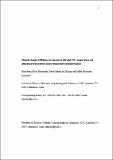Por favor, use este identificador para citar o enlazar a este item:
http://hdl.handle.net/10261/21118COMPARTIR / EXPORTAR:
 SHARE SHARE
 CORE
BASE CORE
BASE
|
|
| Visualizar otros formatos: MARC | Dublin Core | RDF | ORE | MODS | METS | DIDL | DATACITE | |

| Título: | Diurnal changes of Rubisco in response to elevated CO2, temperature and nitrogen in wheat grown under temperature gradient tunnels. |
Autor: | Pérez Pérez, Pilar CSIC ORCID ; Morcuende, Rosa CSIC ORCID ; Martín del Molino, I.; Martínez-Carrasco, Rafael CSIC ORCID | Palabras clave: | Triticum aestivum Carbohydrates Diurnal Elevated CO2 Elevated temperature Nitrogen Protein Rubisco regulation. |
Fecha de publicación: | 2005 | Editor: | Elsevier | Citación: | Environmental and Experimental Botany,2005. 53, 13-27. | Resumen: | Growth at elevated CO2 and temperature often leads to decreased Rubisco activity. We investigated the effects of increased CO2, temperature and nitrogen on the diurnal changes in the control of ribulose-1,5-bisphosphate carboxylase oxygenase (Rubisco) activity in wheat (Triticum aestivum L.). Spring wheat was grown at ambient and 700 μmol mol-1 CO2, under ambient and 4 ºC warmer temperatures, and with two levels of nitrogen supply in field tunnels in a Mediterranean environment. At ear emergence, elevated CO2 increased Rubisco activation, but decreased Rubisco protein and, with high nitrogen, Rubisco specific activity, and had no effect on the rbcS transcript. Warmer temperatures tended to decrease the rbcS mRNA level and Rubisco protein, although the effect on Rubisco activity was small. High nitrogen decreased Rubisco activation or specific activity, depending on the CO2 concentration. It increased Rubisco protein at the end of the night, but accelerated its diurnal loss. The main changes after anthesis were the disappearance of the decrease in Rubisco specific activity caused by elevated CO2, an increase in this activity with above-ambient temperatures combined with high nitrogen, and that high temperature and nitrogen did not affect Rubisco protein contents. This study suggests that decreased leaf protein and increased levels of a Rubisco inhibitor, rather than gene repression by sugars, are involved in acclimation to elevated CO2. High nitrogen increases this down regulation. Changes during growth in levels of leaf metabolites and protein may alter the relative importance of levels of inhibitors and Rubisco amounts for Rubisco regulation. | Versión del editor: | http://www.sciencedirect.com/science | URI: | 10261/21118 | DOI: | 10.1016/j.envexpbot.2004.02.008 | ISSN: | 0098-8472 |
| Aparece en las colecciones: | (IRNASA) Artículos |
Ficheros en este ítem:
| Fichero | Descripción | Tamaño | Formato | |
|---|---|---|---|---|
| Environ Exp Bot_53_2005.pdf | 348,84 kB | Adobe PDF |  Visualizar/Abrir |
CORE Recommender
SCOPUSTM
Citations
65
checked on 12-abr-2024
WEB OF SCIENCETM
Citations
61
checked on 23-feb-2024
Page view(s)
442
checked on 23-abr-2024
Download(s)
194
checked on 23-abr-2024
Google ScholarTM
Check
Altmetric
Altmetric
NOTA: Los ítems de Digital.CSIC están protegidos por copyright, con todos los derechos reservados, a menos que se indique lo contrario.
